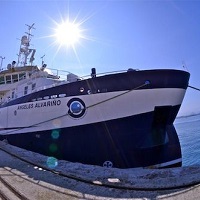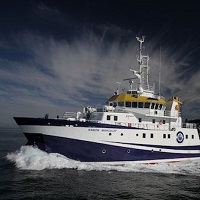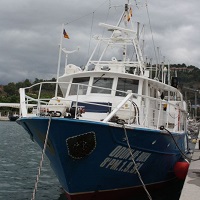Keyword
Bacteria environmental parameters
20 record(s)
Type of resources
Categories
Topics
INSPIRE themes
Keywords
Contact for the resource
Provided by
Years
Formats
Status
-
The Western Iberian Margin (WIM) the area of interest for this cruise is located at the slope of the Southwest coast of Portugal (depths from 200 to 800 meters), where otter trawling is occurring on a continuous base, targeting Norway lobster (Nephrops norvegicus). The area includes fishing grounds with different levels of impact (from no fishing to intense trawling and fixed nets). We identified three main objectives for this sampling campaign: 1) Identify areas of high and low fishing intensity by means of side scan sonar and ROV exploration 2) Sample different areas/depths between 200 and 1000 m water depth for benthos with box corer and multiple corer 3) Collect sediments from the fished and the non‐fished site with box corer or multiple corer for onboard experiments in which different measures of ecosystem functioning will be measured 4) Collect colonization trays at food fall site with the ROV (uAveiro)
-

The general objective of SponGES 0617 expedition on board R/V Angeles Alvariño (IEO) was the study of sponge grounds in the Aviles Canyon System and Le Danois Bank (Study cases of SponGES project nº 4 and 5) where we had knowledge of their existence in the previous projects of IEO in the area (ECOMARG, INDEMARES, ESMAREC), in order to complete the objectives of SponGES project. Specific objectives: 1. Sampling of the structuring sponge species for both anatomical and morphological description and their identification through molecular tools. 2. Collection of samples that will be part of the reference collections, for the sponge grounds species and of the associated fauna. 3. Study of the associated fauna in areas of the target species and in nearby control areas. 4. Sampling of the microbial fauna associated with the target sponge species. 5. Investigate the microbial fauna in sea water collected by rosette and control sediments (Box Corer). 6. Transects with the Politolana ROTV for describing the habitats of structuring species using photogrammetric techniques based on qualitative and quantitative data (presence / density / abundance), as well as environmental data. 7. Sampling for reproductive ecology and genetic structure of target species.
-

The goals of this campaign are framed within the objectives of the overall project, being the experimental cruise of the proposal. Thus, this cruise will help to: - Characterize the different modes of variability of heat and mass transport in easternorth atlantic subtropical gyre. - Determine the structure of the current when it reaches the Canary Islands, mass transport, heat and nutrients and interannual variability. - To determine the correlation between heat and mass transport with the NAO atmospheric and oceanic index. - Characterize the annual cycle in the physical conditions of the surface layers and mixture to where the seasonal cycle is significant, relating it to the meteorological forcings. - Characterization of changes in water masses, mainly in the North Atlantic Central Water (NACW), in Antarctic Atlantic Intermediate Water (AAIW) in Mediterranean Water (MW) and bottom waters of the Canary Basin, in based on temperature, salinity, nutrients and oxygen. - Quantify CO2 transport through atmosphere-ocean of latitude 29 ° N. - Continue with the steps taken for over a year south of La Restinga (El Hierro island) to study the evolution of the physico-chemical on the area of influence of the underwater volcano.
-

The fertilization of phytoplankton by the Iberian upwelling is responsible for the production of ∼250,000 t year-1 of blue mussels in the Galician Rías. This amount represents 95% of the Spanish and 50% of the European production, respectively. This production is jeopardized every year by species from the genera Dinophysis and Pseudo-nitzschia, responsible for lengthy shellfish harvesting closures due to accumulation of diarrhetic (DSP) and amnesic (ASP) shellfish poisoning toxins, respectively, above regulatory levels. Previous studies in this region and others in Europe indicate that these species frequently aggregate forming “thin layers”. Less than five meters thick and up to several km in horizontal extension, these layers have important implications for the management of molluscan shellfish safety. Despite this, the frequency of occurrence of thin phytoplankton layers in the Galician Rías, and the role of mixing conditions in their formation and persistence remains unknown. This project combines field observations in the Galician Rías, time series analysis, and empirical and numerical modeling with the aim of 1) investigating the role of mixing on resource availability and phytoplankton bloom initiation, maintenance and dissipation, 2) describing the frequency and spatial distribution of thin layers of phytoplankton (TLP), and 3) investigating the mechanisms responsible for the formation of TLP.
-

The main objectives are understanding the inter-annual variability of Bluefin Tuna spawning sites and the application of operational oceanography to the conservation and management of tuna species in the Balearic Sea. The main activities have focused on the development of predictive models of Bluefin Tuna spawning locations.
-

1-Determinar la influencia del escenario hidrográfico en la estructura, distribución y condición de las poblaciones larvarias de atún rojo Atlántico en el Mar Balear. 2-Evaluar la fiabilidad de los modelos de hábitat de puesta ya desarrollados para la especie, incluyendo las primeras versiones del modelo operacional. 3-Definir la ecología trófica de larvas y postlarvas de atún rojo Atlántico en el Mar Balear, considerando tanto su relación directa o indirecta con otros grupos planctónicos (picoplancton bacteriano, micro y mesozooplancton), como las interacciones entre larvas de túnidos de distintas especies y/o tallas. 4-Calcular un Indice Larvario para la estimación de la biomasa del stock reproductor. 5-Obtener coeficientes de calibración que permitan estandarizar los resultados obtenidos en muestreos cuantitatives de larvas de túnidos con distintos tipos de redes y metodologías de pesca. 6-Determinar la influencia ambiental en la estructuración vertical de las poblaciones larvarias de túnidos, y de ésta, considerando sus variaciones nictimerales y ontogenéticas, en algunos de los parámetros biológicos y fisiológicos de las larvas.
-

The main objectives are understanding the inter-annual variability of Bluefin Tuna spawning sites and the application of operational oceanography to the conservation and management of tuna species in the Balearic Sea. The main activities have focused on the development of predictive models of Bluefin Tuna spawning locations.
-

The main objectives are understanding the inter-annual variability of Bluefin Tuna spawning sites and the application of operational oceanography to the conservation and management of tuna species in the Balearic Sea. The main activities have focused on the development of predictive models of Bluefin Tuna spawning locations.
-

Study the role of B vitamins on the community structure, activity and succesion of the microbial plankton in a coastal upwelling system.
-

Study the role of B vitamins on the community structure, activity and succesion of the microbial plankton in a coastal upwelling system.
 Catálogo de datos del IEO
Catálogo de datos del IEO